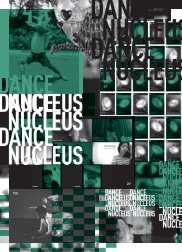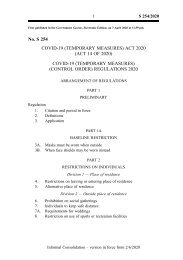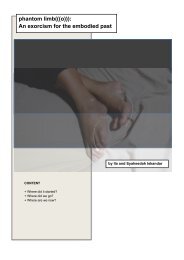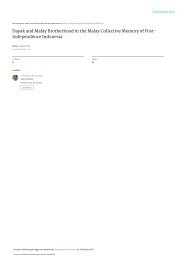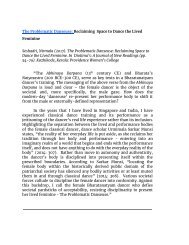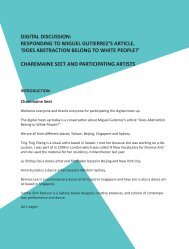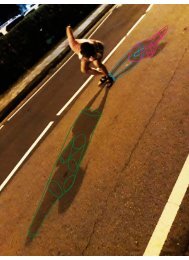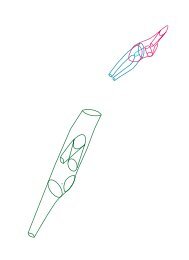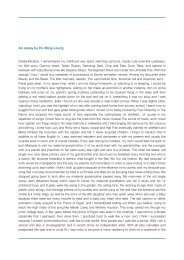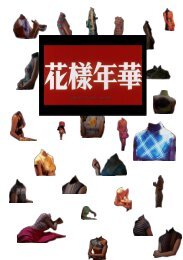FUSE#2
FUSE is a bi-annual publication that documents the projects at Dance Nucleus .
FUSE is a bi-annual publication that documents the projects at Dance Nucleus .
You also want an ePaper? Increase the reach of your titles
YUMPU automatically turns print PDFs into web optimized ePapers that Google loves.
Element#2<br />
BAHASA KOREOGRAFI<br />
The Lenggang as Entry<br />
into Cross-Gender<br />
Performance Research<br />
and Practice<br />
by Soultari Amin Farid<br />
I questioned about my queer self in performing the Lenggang<br />
especially since I contend that my effeminate nature gives me<br />
access and competency to perform the gendered variations<br />
of the “Lenggang”. At the same time via an emic lens as a<br />
dancer and choreographer within the Singapore Malay<br />
dance art world, I am very informed about the conventions<br />
and taboos of how the Lenggang should and should not be<br />
performed. The issue of gender takes prominence because<br />
of its gender-rigid conventions and the heteronormative<br />
narrative of the courtship between an adolescent man and<br />
woman.<br />
It is expected that the female Lenggang demonstrates the<br />
qualities of an ideal Malay woman who is demure, fragile and<br />
cautious of her every movement. She consumes smaller<br />
spaces thus her movement should not be big, i.e. not as big<br />
as her male counterpart, she does not look directly at him<br />
but offers occasional glances of interest -- most times her<br />
eyes are directed downwards. Her hips are her most<br />
important asset, she controls it and manoeuvres it at will –<br />
the extent of her hip motion provides labels to be imposed<br />
on her. The subtle hip motions depict a chaste woman as<br />
oppose to vigorous motions which may give the impression<br />
of a woman who is wild and flirtatious.<br />
I showed examples later from dance manual books published in the early 60s of<br />
Malay social dances and choreographed couple dances. Within the book, notation<br />
of ballroom shoe icons showed where the feet should move but there was no<br />
indication about how the upper limbs should be. Instead the descriptions of hand<br />
and arms gestures are written as text.<br />
One of the manuals entitled “Chara Menari Ronggeng dan<br />
Mak Inang” (1965), provides this example. In the book it is<br />
written that,<br />
“when dancing please do not allow hands to be stiff.<br />
Dancing means to move with the whole body gracefully. So<br />
when we move forward with right feet, the right hand must<br />
sway to the back, as if walking. The left then must sway to<br />
the front, when the feet is in front as mentioned. When<br />
swaying hands, the shoulder must follow the direction of the<br />
hand that is swaying. Whenever we sway our hands, ensure<br />
2<br />
that the hands are bent a little bit. Do not make it too straight,<br />
2<br />
so that it does not look stiff.” (2)<br />
In addition, it is advised too that, “the steps of the ladies are<br />
similar to that of the gentlemen. The only difference is when<br />
the gentlemen’s initial step forward is on the right, the ladies<br />
will step left backwards. It is necessary that the ladies<br />
3<br />
perform the dance gracefully” (2).<br />
The male Lenggang is executed big with wider swinging<br />
arms and rigorous feet motions. He focuses is vision on his<br />
female counterpart giving the impression that she is the<br />
apple of his eye. His movements ranges from the sharp<br />
motions found in Silat, Malay martial arts, and turns fluid<br />
when he communicates his affections to her through floral<br />
gestures depicting the blossoming of flowers.<br />
2<br />
“Waktu menari jangan-lah di-biarkan tangan kita kaku sahaja. Menari bererti bergerak dengan keadaan seluruh tuboh<br />
kita lemah-gemalai. Jadi apabila kita maju sa-langkah ka-hadapan dengan kaki kanan kita pula hendaklah di-hayunkan<br />
ka-belakang, sa-akan2 kita berjalan. Tangan kiri pula hendak-lah di-hayunkan ka-hadapan menurut langkah kaki<br />
kanan ka-hadapan tadi. Waktu menghayunkan tangan, bahu kita hendak-lah ikut ka-arah tangan yang di-hayunkan.<br />
Apabila kita menghayunkan tangan biar-lah tangan kita di-bengkokkan sadikit. Jangan terlampau lurus, supaya tidak<br />
kelihatan kaku” (2)<br />
3<br />
“Gerak langkah bagi penari perempuan pun sama juga dengan gerak langkah untok lelaki. Hanya yang berlainan ia-lah<br />
apabila lelaki memajukan langkah pertama ka-hadapan dengan kaki kanan, penari perempuan mundor dengan kaki<br />
kiri sa-langkah ka-belakang. Hendak-nya penari perempuan melakukan tarian ini dengan lemah lembut” (2)<br />
63 64




